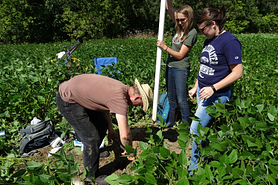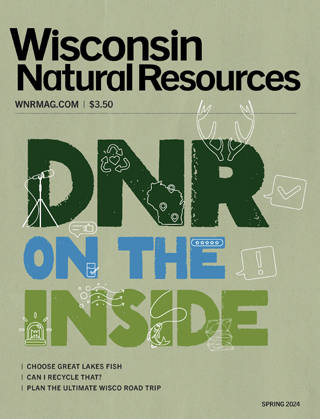Mitigation matters for Wisconsin wetlands
DNR PROGRAM TACKLES RESTORATION, TARGETS GREATER CONSERVATION
Andrea Zani and Raechelle Belli
 In Manitowoc County, wetlands are being returned to a 79-acre parcel at Woodland Dunes Nature Center.
In Manitowoc County, wetlands are being returned to a 79-acre parcel at Woodland Dunes Nature Center.©CHRIS CAPLAN
Since the DNR's In-Lieu Fee Program, the Wisconsin Wetlands Conservation Trust, began five years ago, its work has centered on mitigation of wetlands – restoring vital wetlands as part of a process required by state law. Now, the WWCT has high hopes to do much more, holding true to its name and turning attention to broader water conservation goals.
"To date, the WWCT has focused on wetland mitigation, but going forward we hope to connect restoration opportunities for a wide range of aquatic resources," said Josh Brown, WWCT program coordinator.
Such a course would allow the WWCT to continue a strong foundation of wetland conservation in Wisconsin.
Wetlands provide numerous environmental benefits such as critical habitat for wildlife, natural purification for surface water and drinking water, and flood storage capacity. Because of their importance to the landscape, wetlands are regulated under state and federal law by the DNR and the U.S. Army Corps of Engineers.
In a nutshell, the WWCT's current focus involves coordinating wetland mitigation projects as outlined by state statute. The WWCT operates in 12 service areas that align with major watersheds of the state, such as the Chippewa River, Rock River and Fox River watersheds.
Wetland mitigation projects are funded by fees paid to the program when wetlands are impacted by development. Mitigation is used to remedy lost ecological values and functions.
"Because of all of the great services wetlands provide, it's important that we provide high-quality mitigation when they are impacted," said Tom Pearce, WWCT projects manager.
Striking a balance for resources
A look at the short history and growing success of the WWCT must start with a basic primer on the mitigation process designed to ensure no net loss of wetlands.
 Wetlands are vital to Wisconsin's ecosystem, providing natural water purification, important wildlife habitat and floodwater storage.
Wetlands are vital to Wisconsin's ecosystem, providing natural water purification, important wildlife habitat and floodwater storage.© ZACH KRON
To adhere to legal statutes when a development project impacts identified wetlands, the permit holder can be obligated to mitigate that impact. This is accomplished by restoring wetlands somewhere else in the same watershed.
The permit holder may complete their mitigation through the purchase of "credits" from a private wetland mitigation bank, where wetlands have already been restored. This is the preferred first option. If no bank credits are available in a service area, the permit holder may purchase credits from the WWCT.
Private mitigation banks are typically run, as the name indicates, by private citizens. The WWCT has a different model, funding conservation organizations, municipalities or private groups that apply to complete wetland mitigation projects, including projects on DNR-owned lands.
The number of credits required for a project is determined by the Army Corps of Engineers and DNR as part of the permitting process. A mitigation credit is the equivalent of 1.45 acres of wetland impact.
When development projects must use the WWCT, funds from several WWCT mitigation credit sales in a service area are then combined and used by the DNR program to fund restoration projects.
The WWCT was established in 2014 when its program Memorandum of Understanding was approved by the Army Corps of Engineers and the U.S. Environmental Protection Agency. With this guidance in place, the DNR could begin to offer the sale of required mitigation credits to permittees, coordinate grant funding using sale proceeds and administer wetland restoration projects with partner groups.
Worth remembering is that wetland restoration handled by the WWCT and other mitigation banks is a very specialized type of restoration required by law when wetland impacts occur.
"Many organizations including Ducks Unlimited, the USDA's Natural Resources Conservation Service and other DNR programs have been doing great wetland restoration for years to also bring back habitat," Brown said. "The WWCT is another type of restoration program, but with a unique set of requirements."
The WWCT does mitigation work that's part of efforts to strike a balance between development and resource protection. Mitigation details are hammered out during the permitting process for a development project that impacts wetlands.
That permitting process involves many requirements and high standards for a simple reason: because wetlands are such a vital part of the landscape.
Keys to project selection
When it comes to undertaking mitigation projects, the WWCT has a selective process, said Zach Kron, project ecologist for the program.
"When looking for mitigation projects, we use a 'watershed approach,'" Kron said. "This means we target projects that have the most bang for their buck in terms of improving the ecological health of the watershed."
Projects are chosen through a quarterly review where each proposal is evaluated and ranked based on criteria that offer the best potential for long-term success. Mitigation projects may be considered for lands anywhere in the state, provided the project is protected by a conservation easement. Upon completion, the land must remain as a restored wetland in perpetuity.
WWCT funding for wetland restoration projects is available when the program sells its credits. Partner groups may then apply for funding from the WWCT to pay for the restoration work.
The WWCT has seven projects currently underway, accounting for about 400 acres across the state. Project teams include DNR staff along with partners such as land conservation groups, municipalities, landowners, consultants and other organizations.
"We have a diverse group of partners, ranging from land trusts to municipalities to private landowners," Brown said. "This diversity of partners is key to program success and finding the best projects possible. We also work with a great group of consultants who implement our projects in the field."
Strong partnerships are a big part of what will allow the WWCT to pursue more comprehensive program efforts going forward, Brown added. Overall conservation efforts beyond just wetland mitigation will be more successful with cooperation and commitment from many, he said.
"We feel that we've laid a strong foundation for not only wetland mitigation now, but hopefully for broader conservation goals in the future."
Improved habitat draws wildlife
Of the WWCT's current restoration projects, one of the most visible is the Davis Nature Preserve in southern Waukesha County, in the Upper Illinois Service Area. This project is adjacent to the Mukwonago River Unit of the Kettle Moraine State Forest and includes 52 acres of wet cropland.
Waukesha County Land Conservancy is the lead for this restoration, with the Nature Conservancy also playing a major role. The WCLC bought the land as a habitat area in 2012, using grant funds from the Knowles-Nelson Stewardship Program and the North American Wetlands Conservation Act.
 At the Davis Preserve in Waukesha County, Meghan Wersel, center, of the Waukesha County Land Conservancy works with volunteers to install monitoring wells.
At the Davis Preserve in Waukesha County, Meghan Wersel, center, of the Waukesha County Land Conservancy works with volunteers to install monitoring wells.© WAUKESHA COUNTY LAND CONSERVANCY
Much of the site features potentially restorable wetland, area that was drained for agricultural purposes. Restoration plans call for it to be returned to wet prairie and sedge meadow following construction this year.
"This restoration project will have a significant impact on water quality and aquatic habitat in the Mukwonago River and will allow us to create a wonderful wetland habitat," said Cheryl White, former executive director of the WCLC.
The Mukwonago River is home to 59 fish species and 16 species of native mussels, the WCLC notes, making it one of the most diverse mussel habitats in the state. As part of the restoration project, White noted, an endowment will be established to maintain this important wetland area for years to come.
Another of the WWCT's current projects is at the Woodland Dunes Nature Center in Manitowoc County, on 79 acres known as the Henry Preserve.
The project came together through a variety of partnerships, typical of many WWCT projects. The site consists of a land donation by one neighbor, a land purchase by Woodland Dunes from another neighbor, and purchase of a conservation easement on yet another parcel.
The project will remove drain tiles used for agriculture and create shallow scrapes to restore wetland hydrology. The site will then be planted to wet prairie, sedge meadow and shrub wetland.
"Through a lot of patience and hard work, we were able to put together a great wetland restoration," said executive director Jim Knickelbine. "Woodland Dunes is very excited to watch the restoration grow and develop over the coming years."
Spotlight on restorations
Other ongoing WWCT work includes projects throughout the state.
- In Jackson County, Northern Family Farms, a wholesale tree nursery farm, is working with the WWCT on a project to restore hardwood swamp and sedge meadow to 40 acres of previously cropped field.
- At the western edge of the DNR's Hallie Marsh Wildlife Area in Chippewa County, 44 acres of wetlands will be restored from crop fields to mesic prairie and sedge meadow, better connecting wildlife habitat. The Hallie Marsh Mitigation Project is a partnership among the WWCT, Pheasants Forever and the DNR Wildlife Program.
- Another project named Bohn Farms is located on DNR land at the southwest edge of Lake Poygan in Winnebago County. The project, which will restore 80 acres of wetland next to an existing DNR Glacier Habitat Restoration Area, is a collaboration between the DNR Wildlife Program and Ducks Unlimited.
- And in Plover, a project has broken ground on the former Soik family vegetable farm. The project consists of filling several large ditches and turning off a high-capacity well next to the headwaters of the Little Plover River. Several partners including the Village of Plover, the Wisconsin Potato and Vegetable Growers Association, Wisconsin Wetlands Association and Wisconsin Wildlife Federation have collaborated to make this project possible.
Andrea Zani is managing editor of Wisconsin Natural Resources magazine. Raechelle Belli is a DNR communications specialist working with the WWCT.
HOW WWCT CREDITS WORK
When development work impacts a wetland, a permit may be issued that requires wetland mitigation. The permittee can satisfy their requirement by purchasing mitigation credits, the number of which is specified by the U.S. Army Corps of Engineers and DNR during the permitting process.
The credits typically are purchased from a wetland mitigation bank or the DNR's Wisconsin Wetlands Conservation Trust. Available credits are set by the Corps and vary across the 12 Service Areas, or major watersheds in the state.
Fees per credit also vary and are calculated by factoring in the costs associated with mitigation – land acquisition, project design and planning, construction, monitoring and other factors – as well as costs such as program administration. In the Rock Service Area, for example, 90 mitigation credits have been authorized to sell at a cost of $69,400 each, while in the Lake Superior Service Area, 75 credits were authorized for $60,200 apiece. Once a permit holder completes a purchase for required credits, the WWCT holds all legal responsibility to complete the mitigation project.

